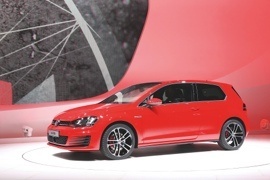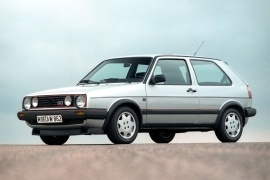
VOLKSWAGEN Golf GTI / GTD / GTE
Generations Timeline, Specs and Pictures

The inventor of the hot-hatch category is back with a new version.
Of course, we are talking about the Golf GTI from Volkswagen. It is one of the icon cars of the automotive industry. Millions and millions of fans around the globe waited for this eighth generation of the GTI.
Despite that it is based on the same MQB platform, launched with the third generation of Audi A3 in 2012, the Golf has succeeded to leave a good impression and the GTI version came with some pretty good improvements. The DCC (Dynamic Chassis Control) system is one of those updates. It continuously reacts to the road surface and driving situations while measuring the steering inputs, braking and acceleration. The main assistance is made to improve comfort depending on the road smoothness, adjusting the four shock absorbers or strengthening them for a sportier driving mode. The DCC also has different pre-set profiles: COMFORT, ECO and SPORT. Plus an “Individual” mode, which can be tailored as desired by the user.
The engine used in the Golf GTI is a 2.0-liter turbocharged gasoline unit. It offers 245 hp and 370 Nm (272 lb.ft) of torque. It is coupled as standard to a 6-speed manual gearbox, but a 7-speed DSG dual-clutch is offered extra. No data regarding its performance was issued at the time of the publishing.

The fastest green Golf was launched at the same moment with its siblings running on gasoline or diesel.
The GTE version is a mix of gasoline and electricity, with the same power as the GTI but less noisy and more ecological.
Maybe the 2020 GTI generation will be the last performance hot-hatch gasoline from Volkswagen. The connection with the cult-car is made via the GTE: a greener, more efficient and economical vehicle. There are some differences on the outside between the GTI and GTE.
First of all, the red-thin line that spans across the front grille toward the hood and sides on the GTI is blue for the GTE. Maybe VW saved the “green” line for a future all-electric hot-hatch. To emphasize that the plug-in is more environmentally friendly, the GTE doesn’t have any exhaust pipes visible on the rear, while the GTI and GTD each show two pipes.
The plug-in hybrid drive of the Golf GTE comprises of a 1.4-liter TSI (turbo gasoline direct injected) engine and an electric motor. The total output power leads to 245 hp, the same as for the GTI, but with bigger torque. The GTE has 400 Nm (295 lb.-ft), while the GTI has 370 Nm (272 lb.ft). Transmission is made via a 6-speed DSG (double-clutch) gearbox.

The first Volkswagen Golf GTD came on the market in the ’80s.
It was the time when people were very happy to see a diesel on the road. Its lower fuel consumption was very convincing. It was 1982 when the first diesel version of the GTI was introduced, wearing the GTD badge. The latest Golf GTD was launched at the same moment as the eighth Golf GTI.
The 2020 Golf GTD has received numerous features to distinguish it from other Golf versions. The full LED headlights are standard and a silver line spans toward the top of the hood. Just to know who just overtook you, the GTD has a dual exhaust pipe on the left of the car. The GTI has one each side and the GTE doesn’t have any visible pipes at all. On top of the vehicle, in the rear, a longer spoiler extends the roofline so the car looks lower than the rest of the Golf range.
Inside, the grey pattern is kept for the diesel-fueled hot-hatch, compared to the red used in the GTI and green for the GTE. An infotainment unit with a 10” touch-screen dominates the central console. This system has the ability to communicate with other vehicles in traffic to exchange information regarding the routes. The system, known as Car2X, will have full functions available when the whole infrastructure in cities will be adopted.

In 2017, the seventh generation Volkswagen Golf GTE received a refresh, coming with more exquisite looks and better performance.
The biggest visual changes can be seen at the front and rear bumpers design, along with some new rims and other small tweaks. Another new feature of this car is the predictive hybrid strategy that works in conjunction with a navigation system. For instance, the car recognizes approaching towns with this strategy and automatically switches over to its zero-emission electric mode in advance. The Golf GTE now also features a full range of the latest assistance and infotainment systems.

After the Dieselgate scandal, Volkswagen tried to prove that it cand build eco-friendly fast vehicles and brought back the GTD version for the Golf lineup in 2013.
Four years later, it refreshed it.
A mild facelift and a few improvements made the seventh generation of the Golf appealing even after four years since its introduction. Its MQB platform was best fitted for its size, and the well-known German hatchback was still on top of the sales charts. To offer a very good performance/running cost version, Volkswagen decided to keep the GTD version on the list.
From the outside, there were just a few small changes to the car. The narrow headlights with incorporated LED daytime running lights made a good impression on the public. A lower chromed strip ran across the front fascia and passed from the grille inside the headlights. The full-LED headlamp system replaced the Xenon option on the list. In the rear, Volkswagen dropped the halogen lamps and offered the taillights fitted with LEDs.
It was the interior that was heavily modified. Volkswagen installed a 12.3” digital instrument panel, inspired by the Audi Virtual Cockpit. On the center stack, the GTD featured an infotainment display with touchscreens. It was available with screen sizes up to 9.2”. The top versions, named “Discover Pro,” featured voice controls and gesture controls.
Under the hood, Volkswagen kept the same 184 hp engine paired as standard to a 6-speed manual gearbox. A 7-speed automatic (dual-clutch) was available as an option.

This is the original hot hatch: the Golf GTI.
And in 2017, the nameplate returned with a facelift and few things to make its buyers buy it again. It is like when you have that brand of a phone that you replace it even if it works great but you want the newer version of it.
The 2017 Golf GTI is the facelift of the 7th generation of the Golf and this is why some people call it the GTI 7.5. If someone needs more horsepower, there is also a Clubsport version now, which offers 265 hp. The sport adaptive suspension is fitted as standard.
From the outside, what you see is what you get. A GTI package with sport suspension, GTI bumpers and badges and, of course, GTI sport light-alloy 18” wheels. As an option, there is even a set of 20” size wheels. It worth mentioning that if other hot hathces are available only in a 5-door configuration, the GTI kept the 3-door version as an entry level.
On the inside, there is a GTI badge on the steering wheel, a golf-ball decoration for the shifter and a set of retro-themed bucket-type seats. The driver has a 12.3” TFT dashboard display for the speedometer and tachometer and an 8” color touch-screen for the infotainment system.

Volkswagen introduced the GTE as a plug-in hybrid for the hot-hatch market, which was an unusual decision, but it was a bold move that paid off.
Volkswagen Golf was a successful car, and regardless of the engine version, it was a sales-winner on all the markets. Also, the Golf GTI was considered the inventor of the hot-hatch segment, which it dominated for decades. But, as times changed, the German carmaker offered the hot-hatch in the form of a plug-in hybrid, which was not a slow car either. While the first GTI could do a 0-100 kph (0-62 mph) in less than 10 seconds with a 4-speed manual, the 2014 GTE could do much better than that.
The exterior design is instantly recognizable Golf. There are some small details to tell the difference. On the front, there was a blue line that went across the grille and continued inside the headlights. The bigger front bumper included side air-scoops and a grille that sported a honeycomb mesh design. The aerodynamic side-sills made the car look sportier, and so was the rear roof spoiler. Volkswagen installed the 16” light-alloy wheels as standard with an option for 17” or 18”, respectively. Unlike most plug-in hybrid vehicles that didn’t show any exhaust, the GTE featured twin pipes in the rear.
Inside, there were some classic design cues and some modern touches. For instance, the upholstery had the same pattern as the original Golf GTI, with slim blue lines instead of red. The instrument panel featured big round dials for the speedometer and a power meter that supplemented the tachometer.
Under the hood, the carmaker installed a dual system with a 1.4-liter turbocharged gasoline unit that provided 150 hp and an electric motor that offered 102 hp.

The Golf GTD stepped into his brother’s shoes and became a hot-hatch icon among the diesel fans across Europe.
It was fast, fuel-efficient, and with respectable torque for its size.
The first Golf GTD was introduced in 1982 and it only offered 70 hp, which were about 45 less than on the GTI. But the idea was well-received by the public. It offered enough fun at the fraction of cost for fuel. In 2013, the GTD offered less power but more torque than the much acclaimed GTI version.
The outside design is instantly recognizable Golf. There are some small details to tell the difference. On the front, there was a red line that went across the grille and was continued inside the headlights. The bigger front bumper included some air-scoops and the narrow grille had a honeycomb mesh design. The aerodynamic side-sills made the car look sportier, and so was the rear roof-spoiler. Due to its 3-door bodywork, the hot-hatch appearance was granted. It rode on standard 17” light-alloy wheels. In the rear, it featured twin exhausts on one side.
Inside, there were some classic design cues and some modern touches. The three-door version featured a longer door when compared with the 5-door version, but offered the same roomy interior for the backseats. The instrument panel though it was modern, with big round dials for the speedometer and tachometer. Between those two there was a small LCD display for the on-board computer. The infotainment unit was on the center console and it could feature a navigation system.
The all-wheel independent suspension and the optional adaptive dampers made the car planted to the road. And that was a must, considering the 2.0-liter turbodiesel engine under the hood.

The Golf GTI is the most famous hot-hatch car on the market.
It appeared in the mid-’70s and it was produced ever since. In 2013 it reached its seventh generation and, along with it, came the diesel version: the GTD.
The first Golf GTD was introduced in 1982 and it only offered 70 hp, which were about 45 less than on the GTI. But the idea was well-received by the public. It offered enough fun at the fraction of cost for fuel. In 2013, the GTD offered less power but more torque than the much acclaimed GTI version.
The outside design is instantly recognizable Golf. There are some small details to tell the difference. On the front, there was a red line that went across the grille and was continued inside the headlights. The bigger front bumper included some air-scoops and the narrow grille had a honeycomb mesh design. The aerodynamic side-sills made the car look sportier, and so was the rear roof-spoiler. Standard 17” light-alloy wheels were fitted. In the rear, it featured twin exhausts on one side.
Inside, there were some classic design cues and some modern touches. The three-door version featured a longer door when compared with the 5-door version, but offered the same roomy interior for the backseats. The instrument panel though it was modern, with big round dials for the speedometer and tachometer. Between those two there was a small LCD display for the on-board computer. The infotainment unit was on the center console and it could feature a navigation system.
The all-wheel independent suspension and the optional adaptive dampers made the car planted to the road.

The Golf GTI is the most famous hot-hatch car on the market.
It appeared in the mid-’70s and it was produced ever since. In 2013 it reached its seventh generation.
The Golf GTI (or Gran Tourer Injection) model was the car designed to satisfy the younger customers with some performance. The first GTI could do a 0-100 kph (0-62 mph) in less than 10 seconds with a 4-speed manual. That time continued to be enhanced from generation to generation.
The outside design is instantly recognizable Golf. There are some small details to tell the difference. On the front, there was a red line that went across the grille and was continued inside the headlights. The bigger front bumper included some air-scoops and the narrow grille had a honeycomb mesh design. The aerodynamic side-sills made the car look sportier, and so was the rear roof-spoiler. Standard 18” light-alloy wheels were fitted. In the rear, it featured two side exhausts.
Inside, there were some classic design cues and some modern touches. For instance, the upholstery had the same pattern as the original Golf GTI. The instrument panel though it was modern, with big round dials for the speedometer and tachometer. Between those two there was a small LCD display for the on-board computer. The infotainment unit was on the center console and it could feature a navigation system.
The all-wheel independent suspension and the optional adaptive dampers made the car planted to the road.

Volkswagen introduced the sixth generation of the Golf in 2008 and, along with it, unveiled the GTI version as well, continuing the long history of the most famous hot-hatch in the world.
The world was struggling with a world financial crisis, and Volkswagen had to make a decision regarding the Golf range. The fifth-generation was already on the market for seven years, but it wasn’t the perfect time to launch a completely new model. In the end, the carmaker took the middle road by using the same PQ35 platform from the Golf V, re-draw the bodywork and install a new interior.
From the outside, the Golf VI GTI featured two distinct red stripes across the honeycomb grille. It visually connected the new, angular headlights that made the car looks more aggressive. At the back, the car featured two side exhausts with chromed tips.
Inside, the fifth Golf generation was criticized for its low-quality materials, but the carmaker fixed that along with the 2008 generation. There was a soft-touch material on the dashboard that improved the premium feel. Like any other GTI, the 2008 model featured sport bucket-seats with high-bolstering to keep their occupants in place during high-speed cornering.
Under the hood, Volkswagen installed a 2.0-liter turbocharged engine that provided 200 hp. It sent the power to the front wheels only via a six-speed manual or a six-speed automatic gearbox. There were other two special editions for the Golf GTI: the 235 hp 35th anniversary and the 210 hp GTI Worthersee.

When Volkswagen introduced the Golf VI at the 2008 Paris Motor Show, it brought the GTI version too, with three and five-door bodies.
Even though it wasn’t the fastest hot-hatch anymore, the Golf GTI remained a cult car. Volkswagen offered even more powerful versions for the Golf, such as the Golf R, but the GTI remained a sought-after vehicle. The five-door version was the perfect mix between a compact family hatchback and a sporty vehicle. But the 2008 Golf was, actually, a major facelift for the Golf MK5 named as MK6.
Despite having five doors, the car kept the original features of the three-door GTI. It featured an aggressive styling with a big central grill in the front bumper. A pair of side scoops on the outer sides of the apron helped to cool the brakes. The main radiator grille sported two horizontal silver slats and the GTI’s chromed badge. To complete the sporty image, the 2008 GTI featured a short roof spoiler and two exhausts mounted on the outer sides of the rear bumper.
Inside, the three-spoke steering wheel featured a sporty design and the GTI letters on the lower spoke. The dashboard layout was similar to a well-equipped Golf, with the infotainment unit on the center stack, above the climate control unit. Its unique Tartan upholstery resembled the original Golf MK1 GTI. Thanks to a five-door configuration, it was a suitable car for a family but quick enough for a sporty drive.
Under the hood, Volkswagen installed a 2.0-liter turbocharged gasoline engine paired to a standard 6-speed manual, and the power went to the front wheels. As an option, a 6-speed DSG (dual-clutch) automatic was available. Two paddle-shifters were placed behind the steering wheel for + and – gear changes if the DSG was installed.

The Golf GTD was for the diesel hatchbacks that the Golf GTI was for the gasoline version: a sporty car with big appeal to the young people.
In the diesel version it had a better fuel-efficiency.
In 2009, Volkswagen introduced the Golf GTD at the Leipzig Auto Mobil International Show. It was shown in both versions, with three and five doors. That was not the first GTD in history. The first generation appeared in 1982 on the first generation of the Golf. It offered 70 hp from its 1.6-liter turbocharged diesel engine. Fast forward to 2009.
The sixth generation of the Golf also featured a GTD version, along with the GTI. It was offered in three or five doors. The three doors, offered a sportier look for the car, with its honeycomb grille, 17” light-alloy wheels and chromed details on its front fascia. In the rear, there was a twin-exhaust and a roof-spoiler. The only differences from the outside, when compared with the GTI, were the badges and the standard wheels.
Inside, Volkswagen is known for offering a wide customization program. The standard vehicle featured cloth seats with specific design, an on-board computer display between the chromed rounded dials on the instrument cluster, and a decent infotainment system.
Under the hood there was a 2.0-turbodiesel engine that offered 100 horsepower more than the original GTD. It was mated to a 6-speed manual fitted as standard or a 7-speed DSG with dual-clutch technology.

In 2008, at the Paris Motor Show, Volkswagen unveiled the sixth generation of the Golf.
It was a surprising move from the fifth generation, which was on sale for only five years.
The sixth-generation was more of a re-work of the fifth generation since it shared the same platform PQ35. In 2009, based on the Mk6, the car-maker launched the Golf GTD. An oil-burner with hot-hatch performance and high fuel efficiency.
The GTD was the diesel version of a Golf GTI. It featured an aggressive styling with a big central grille in the front bumper and two side air-intakes for the disc-brakes. In those air-intakes, the constructor installed the fog-lights. The radiator grille featured two horizontal silver lines and a chromed badge with the GTD letters. In the back, a short roof-spoiler was installed over the tailgate.
Inside, the three-spoke steering wheel featured a sporty design, and the GTD letters on the lower spoke. The dashboard layout was similar to a well-equipped Golf, with the infotainment unit on the center stack, above the climate control unit. Thanks to a five-door configuration, it was a good car for a family, but quick enough for a sportier drive.
Under the hood, there was an upgraded 2.0-liter turbodiesel engine mated to a standard 6-speed manual gearbox. The power went to the front wheels. As an option, a 6-speed DSG (dual-clutch) automatic was available. If a DSG was installed, two shift-paddles were installed behind the steering wheel for + and – gear changes.

When Volkswagen introduced the fifth generation of the Golf in 2003, its fan base awaited the GTI version, which was available in a traditional three-door version or a more conservative five-door configuration.
The German carmaker knew that it had to dust off the GTI nameplate and bring it back to its shine since the GTI’s fourth generation wasn’t that appreciated. It was more of a family car with a sportier engine, but it wasn’t a true hot-hatch. Well, the fifth generation came to satisfy its customers.
First of all, the car came with a specific exterior package consisting of a different bumper with wider side scoops, which hosted the fog lamps. A red trim adorned the mesh-grille with a hexagonal pattern, while on the side, it sported specific light-alloy wheels. Thanks to its lower ground clearance than the rest of the range and the roof spoiler on top of the tailgate, the three-door GTI couldn’t be mistaken with its lower-powered siblings.
The car’s interior featured a pair of bucket seats with GTI lettering embroidered on the headrests. Just in case that the owner didn’t know what’s under the hood, the carmaker installed a specific steering wheel with a silver trim on the lower spoke, stamped with the GTI badge. Depending on the options, Volkswagen installed a new infotainment system with a wider screen and sat-nav on the center stack. The customer could choose between the basic cloth materials or the more expensive leather upholstery.
While the fourth generation could hardly convince with its powerplant, the fifth sequel of the GTI saga featured a 2.0-liter turbocharged unit with a direct fuel injection system. It sent the power to the front wheels via a standard six-speed manual or, as an option, through a six-speed automatic (dual-clutch) DSG transmission.

Volkswagen introduced the Golf’s fifth generation on the market in 2003, and, in the following year, the carmaker brought the most-wanted version: the GTI.
The first generation of the Golf used the GTI version for its sportiest version. Later on, the carmaker introduced special versions such as the R32, which offered more power. But the GTI badge remained the most respectable among Golf’s fans, and the 2004 model was no exception.
Volkswagen knew that teenagers from the ’70s when it launched the first GTI were already parents by 2004 and needed more room and comfort for their families. Thus, it was no wonder that it offered the GTI with a five-door shape and brought more comfort for its occupants without cutting the performance or thrills. Regardless of the body version, all Golf’s V GTIs sported a different aerodynamic package than the rest of the range. At the front, it featured a lower apron with a deeply sculptured grille in the middle and two side-pods for the fog-lights. The lower part of the grille was decorated with a red stripe and a chromed GTI badge. It featured a dual chromed exhaust on the side and a roof spoiler at the top of the tailgate in the rear.
Inside, Volkswagen installed high-bolstered bucket-seats with GTI lettering embroidered in the headrests. Exclusively for this version, the Golf sported a GTI badge on the steering wheel’s lower spoke. In the back, the five-door GTI featured Isofix anchoring points for child seats on the split-folding bench.
Under the hood, the carmaker installed a 2.0-liter turbocharged gasoline engine with a direct fuel injection system. It paired it either to a six-speed manual or to a six-speed automatic (dual-clutch) DSG transmission.

It was the last naturally aspirated Golf GTI, but it wasn’t as special for its era as its predecessors were in their times.
When Volkswagen introduced the third generation of the Golf, its fans were stunned, but not in appreciations. The car featured a completely different styling, and the top version was just slightly quicker than the older Golf II GTI. It wasn’t that much of a hot-hatch as it was before. Moreover, there were family sedans with lower power and better performances.
The rounded shapes of the 1992 Golf GTI were the first reason why its fans didn’t like the car. It was bigger, and the oval-shaped headlights were completely different than the four rounded ones installed on its predecessors. At the front, the bumper featured three intake grilles at the bottom, turn signals, and stationary lamps. In the back, the bumper and apron’s simple design were accepted, along with the twin exhausts.
Inside, the car was clearly addressed to a wider range of customers. There were more comfort features such as the air-conditioning, power windows, and more sound-deadening materials, making the car heavier. The bolstered seats were praised, and the customers didn’t really care if there was a checker-flag design or spots on a canvas.
Under the hood, Volkswagen installed a choice of two engines for the GTI with two power outputs: 115 hp and 150 hp. The more powerful version was just 0.3 seconds quicker than the former Golf II GTI. Opel Kadett GSI, the main competitor for the Golf GTI, offered a 2.0-liter engine with 150 hp and rocketed from 0 to 100 kph (0-62 mph) in 7.7 seconds. That was a second and a half faster than the Golf GTI.

Born in 1984, the Volkswagen Golf II GTI received multiple awards that underline the success this new model had on the market.
However, lots of people say that the first GTI is by far better than the second generation, probably due to the powerful rivals including Peugeot 205 GTI. Getting back to the awards, the Golf II GTI was named the Car of the Year 1985 by the Motor Trend magazine and received the Best Golf of All Time award offered by VW Vortex. What’s interesting is that the Golf II GTI got rivals even in the countries where Peugeot 205 GTI was not so popular. For instance, in North America, Volkswagen Golf II GTI competed with Honda Civic S.

The Golf GTI was the Golf that shouldn’t exist, but since a team secretly developed it and impressed the VW management, they gave it the OK and changed the Golf forever.
Technically speaking, the Golf GTI was not the first hot-hatch globally, but it was the first that enjoyed huge success. While Volkswagen thought it would produce it in just about 5,000 units, it ended up building 462,000! That’s how “the results exceeded the expectations” looked for Volkswagen. The GTI letters stand for Grant Turismo Injection since it was the first fuel-injected engined Golf, and the 1.6-liter 100 hp engine was impressive for those times.
On the outside, the Golf 1 GTI looked very similar to the rest of the range. Its three-door bodywork sported an enhanced front fascia with a red surrounding for the black grille. A chromed GTI badge took its place on the driver’s side. Since Volkswagen equipped the car with wider wheels, it had to install black-plastic wheel-arches extensions. A black apron took its place under the front metallic panel, while the black plastic bumper featured the turn-signals.
Inside, the carmaker decided to create a unique interior with tartan-looking upholstery for the sport bucket seats. The same pattern covered the seating area for the rear bench. Instead of the regular, round, smooth knob for the gear-stick, the designer installed a golf-like ball.
But the essential part of the car was the drivetrain. Its 810 kg (1,786 lbs) weight was low enough so the car could do a 0-100 kph (0-62 mph) run in less than ten seconds. In 1979, Volkswagen introduced the five-speed manual gearbox as standard on the GTI and, three years later, it increased the displacement to 1.8-liter. The GTI showed a lower ground clearance than the rest of the range, and the suspension was stiffer, resulting in an ideal handling vehicle. Soon, it became a must-have vehicle for all petrolheads and ignited the hot-hatch revolution.























































